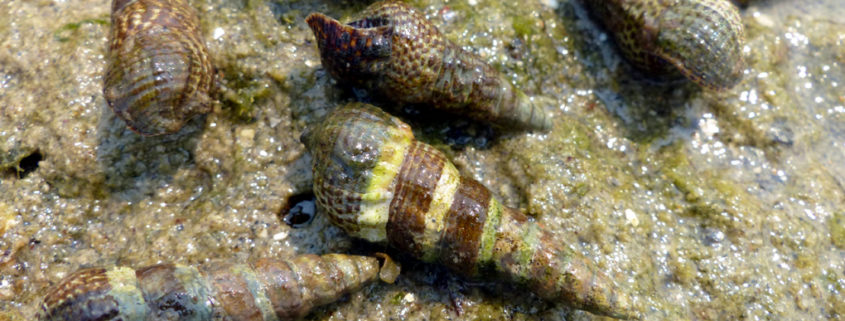Common name: Mudflat Snails; Spiral Snails; Asian Hornsnail Authors: Elliot Scott-Bigsby & Sayde Koetke Scientific name: Batillaria cumingi Size: Up to 3 cm (1 ¼”) in length Identifying features: Shells are small, long, and grey-brown with 8 or 9 distinct circles. Habitat: Found in the mid- to high intertidal zones, including but not limited to salt marshes, mud flats, pannes in estuaries, riparian zones, and wetlands. Despite their large numbers it is sometimes surprising to find out that Batillaria cumingi is an introduced species originating from Japan and parts of Asia. In California this species is slowly replacing the native snail Cerithidea californica: the two species currently coexist in the bays in California. They can be found in bays in British Columbia down to California. References Harbo, R. M (1949). Whelks to Whales: Coastal Marine Life of the Pacific Northwest. Madeira Park, BC: Harbour Publishing. Klinkenberg, Brian. 2017. E-Fauna BC Atlas Page: Electronic Atlas of the Fauna of British Columbia. Retrieved November 9th, 2018 from http://linnet.geog.ubc.ca/efauna/Atlas/Atlas.aspx?sciname=Batillaria%20attramentaria Dave Cowles (2009) Batillaria attramentaria (japanese false cerith, false cerith, zoned cerith, screw shell, tall-spired snails), retrieved november 13, 2019 from: https://inverts.wallawalla.edu/Mollusca/Gastropoda/Prosobranchia/Order_Mesogastropoda/Suborder_Taenioglossa/Family_Batillariidae/Batillaria_attramentaria.html
Interesting resources for research and photographer credit
Latest Projects
VicHigh Marine
Victoria High School
1260 Grant St.
Victoria. BC, Canada
V8T 1C2
Phone: 250-388-5456
Email: dsyoung@sd61.bc.ca




Leave a Reply
Want to join the discussion?Feel free to contribute!